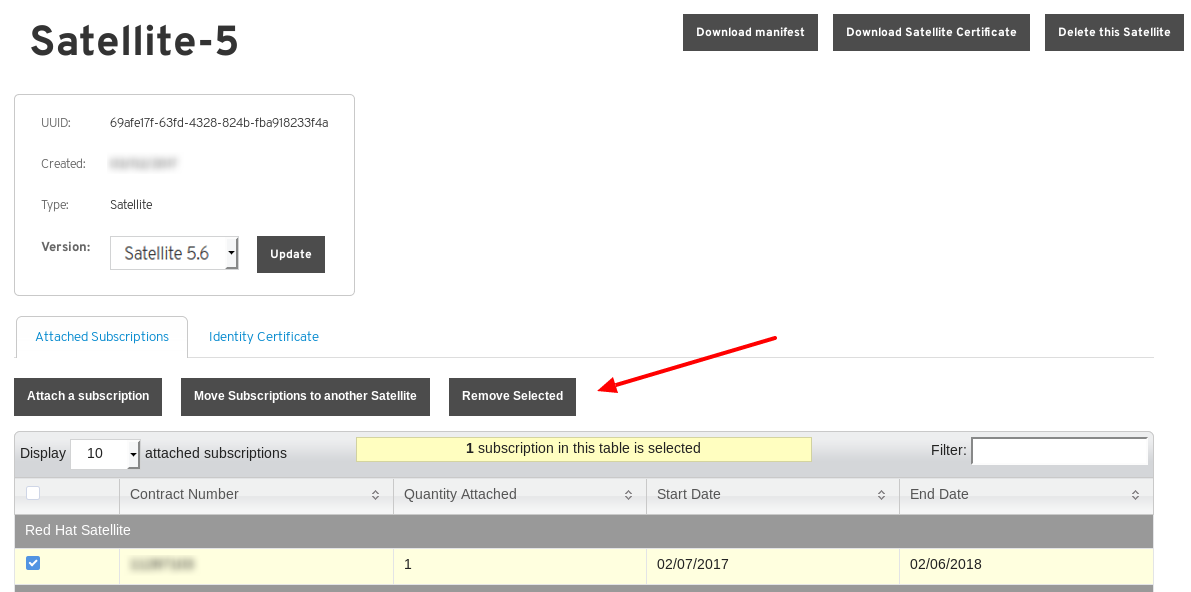Este contenido no está disponible en el idioma seleccionado.
Chapter 11. Migrating from RHN to RHSM
Warning
- Upgrade the Satellite 5 database schema (if required).
- Remove the Satellite 5 registration from Red Hat Network.
- Migrate the Satellite 5 subscription to Red Hat Subscription Management.
Note
- Remove the Satellite 5 registration from Red Hat Network.
- Migrate the Satellite 5 subscription to Red Hat Subscription Management.
Procedure 11.1. Upgrading the Satellite 5 Database Schema
- On the Satellite 5 server, list packages for which updates are applicable.
yum check-update
# yum check-updateCopy to Clipboard Copied! Toggle word wrap Toggle overflow If there is an update pending for thesatellite-schemapackage, complete the procedure detailed in How do I upgrade the database schema of a Red Hat Satellite server?.
Procedure 11.2. Removing the Satellite 5 Host's Subscription from Red Hat Network
- Open a web browser, log into the Red Hat Customer Portal, click Subscriptions, click Satellite in the list of Subscription Management Applications, then click on the Satellite tab.
- Find the desired Satellite instance in the list, and click on the host name.
Figure 11.1. Details of the Satellite 5 Subscription
- Click the check box beside the Red Hat Satellite subscription to be migrated, click , then click to confirm.
Warning
Remove only the Red Hat Satellite subscription. All other subscriptions must remain.The successful removal of the Red Hat Satellite subscription is confirmed by the message: The subscription(s) you selected have been removed. - In the Version drop-down list, select the version of Satellite 5 which you are currently running.
- Click and save the certificate file locally.The Satellite 5 entitlement certificate, contained in the file downloaded, is required in Procedure 11.3, “ Migrating the Satellite 5 Host's Registration ”.
Procedure 11.3. Migrating the Satellite 5 Host's Registration
- Red Hat Network username and password.
- On the Satellite 5 server, ensure that all packages are current.
yum update
# yum updateCopy to Clipboard Copied! Toggle word wrap Toggle overflow - Confirm the version of the
spacewalk-backendpackage is at version2.0.3-42or higher.Note
If this is the Managed DB host, skip this step.rpm -q spacewalk-backend
# rpm -q spacewalk-backend spacewalk-backend-2.0.3-42.el6sat.noarchCopy to Clipboard Copied! Toggle word wrap Toggle overflow Warning
If version 2.0.3-42 (or higher) ofspacewalk-backendpackage is not available, or cannot be installed, do NOT proceed with the migration. Contact Red Hat Support for assistance. - Install the packages
subscription-managerandsubscription-manager-migration.Thesubscription-manager-migrationpackage contains the Satellite 5 subscription script.yum install subscription-manager yum install subscription-manager-migration
# yum install subscription-manager # yum install subscription-manager-migrationCopy to Clipboard Copied! Toggle word wrap Toggle overflow - Record the Red Hat Network username which was used to register the Red Hat Enterprise Linux instance. This username and its password is required in the next step.
grep -A1 name\>username /etc/sysconfig/rhn/systemid
# grep -A1 name\>username /etc/sysconfig/rhn/systemidCopy to Clipboard Copied! Toggle word wrap Toggle overflow In this example, the username isadmin@example.com.<name>username</name> <value><string>admin@example.com</string></value>
<name>username</name> <value><string>admin@example.com</string></value>Copy to Clipboard Copied! Toggle word wrap Toggle overflow - Run the Satellite 5 Red Hat Network to Red Hat Subscription Manager migration script.
rhn-migrate-classic-to-rhsm
# rhn-migrate-classic-to-rhsm Legacy username: Red Hat Network username Legacy password: Red Hat Network passwordCopy to Clipboard Copied! Toggle word wrap Toggle overflow TheLegacy usernameandLegacy passwordare the same credentials which were used to register the server to Red Hat Network. The username was obtained in the prior step.Example output fromrhn-migrate-classic-to-rhsm.Copy to Clipboard Copied! Toggle word wrap Toggle overflow The messageSystem 'satellite.example.com' successfully registered.confirms that the Satellite 5 system's migration to Red Hat Subscription Manager has been successful. In this example, the Satellite 5 server has been given a Red Hat Subscription Management UUID of284e025c-4a60-4084-b49c-4cb26fd7cf93. - Disable all repositories.
subscription-manager repos --disable '*'
# subscription-manager repos --disable '*'Copy to Clipboard Copied! Toggle word wrap Toggle overflow - Enable only those repositories required by Satellite 5.For Red Hat Enterprise Linux 6
subscription-manager repos --enable rhel-6-server-rpms subscription-manager repos --enable=rhel-6-server-satellite-5.8-rpms
# subscription-manager repos --enable rhel-6-server-rpms # subscription-manager repos --enable=rhel-6-server-satellite-5.8-rpmsCopy to Clipboard Copied! Toggle word wrap Toggle overflow - Reactivate the Satellite 5 instance.
Note
If this is the Managed DB host, skip this step.Therhn-satellite-activatecommand requires the certificate downloaded in Procedure 11.2, “ Removing the Satellite 5 Host's Subscription from Red Hat Network ”. In this example, the certificate was saved in fileSatellite-5.cert.rhn-satellite-activate -vvv --rhn-cert=Satellite-5.cert
# rhn-satellite-activate -vvv --rhn-cert=Satellite-5.cert RHN_PARENT: satellite.rhn.redhat.comCopy to Clipboard Copied! Toggle word wrap Toggle overflow When the Satellite Server is reactivated, you may see the following error message. This is expected, and can be safely ignored, because thesystemidfile is the Red Hat Network system ID. The system ID file is deleted when the host's registration is migrated to Red Hat Subscription Manager.ERROR: Server not registered? No systemid: /etc/sysconfig/rhn/systemid
ERROR: Server not registered? No systemid: /etc/sysconfig/rhn/systemidCopy to Clipboard Copied! Toggle word wrap Toggle overflow - Optionally, if Satellite is installed on Red Hat Enterprise Linux 6, remove those packages which were previously used to communicate with Red Hat Network.
Warning
Do not remove these packages if Satellite is installed on Red Hat Enterprise Linux 5. Removing these packages from Red Hat Enterprise Linux 5 will result in the failure of Satellite.yum remove yum-rhn-plugin rhn-check rhn-setup rhnsd
# yum remove yum-rhn-plugin rhn-check rhn-setup rhnsdCopy to Clipboard Copied! Toggle word wrap Toggle overflow
